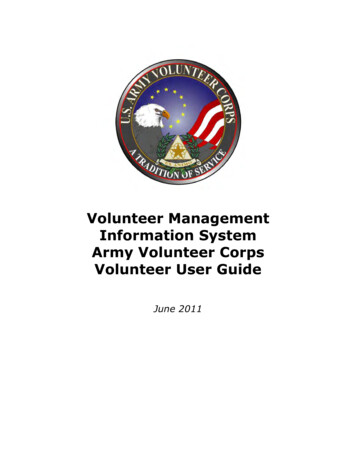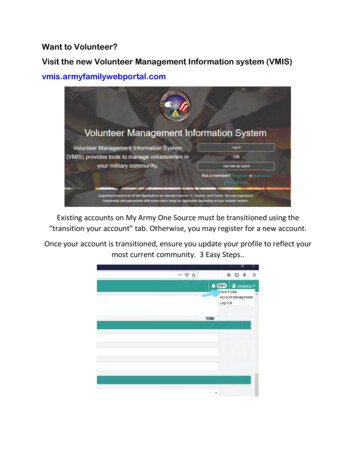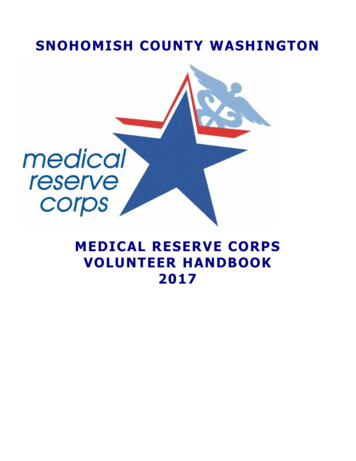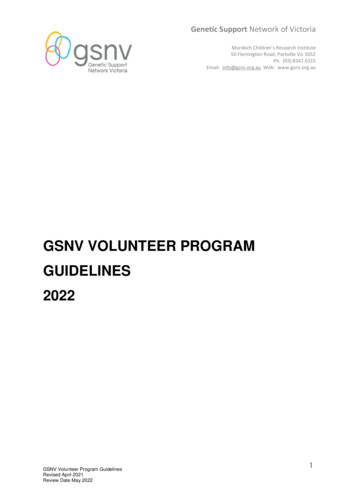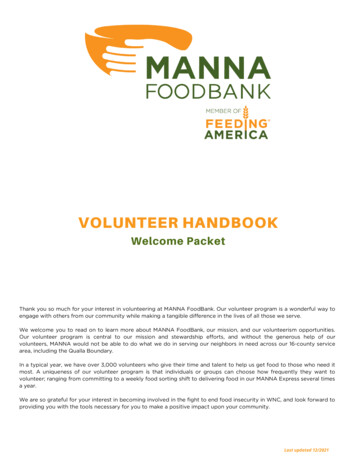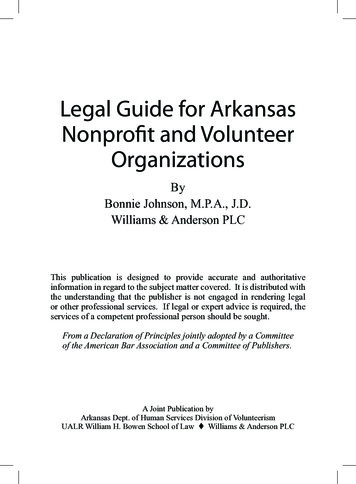
Transcription
VOLUNTEERMANAGEMENTfor Animal CareOrganizationsWow! This fabulous book offers up-to-date information, strategies, and resources to effectively andcreatively engage community volunteers in support of your mission. Betsy McFarland has superblyarticulated a step-by-step process of establishing a vital volunteer program and has shared practicalsolutions to handle obstacles and challenges inherent in the work. I can't wait to give this book tomy local humane society.—Betty B. StallingsAuthor and Trainer, specializing involunteer management and fund developmentVolunteers are the backbone of every successful shelter. Managing them effectively is thekey. If you are just starting a volunteer program, this book can help you plan, writea training manual, and create job descriptions. If you already have a volunteer program,McFarland can help you improve it, with words of wisdom for even the seasoned professional.The bottom line is, if you need volunteers (and what shelter doesn’t?), you need this book!VOLUNTEER M ANAGEMENT for Animal Care OrganizationsShelter Management SeriesShelterManagementSeriesfor Animal CareOrganizationsBy Betsy McFarland—Julie MorrisNational Shelter OutreachAmerican Society for thePrevention of Cruelty to Animalshis book is being used successfully as a textbook in our animal welfare certificate program. It is easyto read and geared specifically to the unique challenges posed by a shelter environment.a must forboth those who are just starting to work with volunteers and for more experienced workers who wouldlike to polish their program.—Michelle Virdee, AHTAnimal Welfare Certificate ProgramThe University College of the Cariboo, CanadaBy Betsy McFarlandT 15.95Humane Society Press2100 L Street, NW, Washington, DC 20037202-452-1100 www.humanesocietypress.orgVOLUNTEERMANAGEMENTMade possible througha generous grant from theMunder Family Foundation
VOLUNTEERMANAGEMENTfor Animal CareOrganizationsBy Betsy McFarland
Betsy McFarland is director of communicationsfor the Companion Animals section of TheHumane Society of the United States (HSUS).She speaks regularly at conferences, bothdomestically and internationally, on sheltervolunteer management. She holds a degreein psychology from George Mason Universityand a certificate in nonprofit business andmanagement from the Johns HopkinsUniversity. She is a member of the Associationfor Volunteer Administration. 2005 by The Humane Society of the United States.All rights reserved.No part of this book may be reproduced in any form or by any electronicor mechanical means, including information storage and retrieval systems,without permission in writing from the publisher, except by a reviewerwho may quote brief passages in a review.Second editionISBN 0-9748400-1-7Library of Congress Cataloging-in Publication DataMcFarland, Betsy.Volunteer management for animal care organizations/by Betsy McFarland.–2nd ed.p. cm.ISBN 0-9748400-1-71. Animal shelters–United States–Personnel management. 2.Volunteers–United States–Management. I. Humane Society of the UnitedStates. II. Title.HV4764.M25 2004636.08'32'0683–dc222004027130Printed in the United States of AmericaHumane Society PressAn affiliate of The Humane Society of the United States2100 L Street, NWWashington, D.C. 20037ii
AcknowledgmentsThis project was made possible through a generous grant from theMunder Family Foundation. Lee Munder envisioned a hands-on manualthat incorporated practical volunteer management tools supported bysolid research on volunteerism. The Humane Society of the United States(HSUS) is proud to fulfill his vision, and we thank him for his generoussupport and thoughtful leadership throughout this project.Many shelter volunteer managers lent their time and expertise tothis project. My sincere thanks go to the following reviewers: Joyce Barton,Potter League for Animals (Middletown, R.I.); Judy Brown, Capital AreaHumane Society (Lansing, Mich.); Maggie Huff, Humane Society ofRochester and Monroe County at Lollypop Farm (Fairport, N.Y.);Champaign County Humane Society (Urbana, Ill.); Tamara Kreigh, FortWayne Animal Care and Control (Fort Wayne, Ind.); Jodi Schulz, DumbFriends League (Denver, Colo.); Christine Titus, Seattle Animal Shelter(Seattle, Wash.); and Tree House Animal Foundation (Chicago, Ill.).Numerous shelter staff members and volunteers patiently and thoroughlyprovided answers to my many questions. A huge thanks goes to everysingle one of them—there are too many to mention by name, butyou know who you are! Additionally, I’d like to thank Betty Stallingsfor lending to this project her expert advice on the volunteermanagement field.Numerous shelters provided sample forms for us to reprint.These include the Arizona Humane Society (Phoenix, Ariz.); CapitalArea Humane Society; Champaign County Humane Society; DumbFriends League; Erie County SPCA (Tonawanda, N.Y.); Fort WayneAnimal Care and Control; Hawaiian Humane Society (Honolulu,Hawaii); the Humane Society of Rochester and Monroe County atLollypop Farm; Iowa City/Coralville Animal Care and AdoptionCenter (Iowa City, Iowa); Larimer Humane Society (Ft. Collins,Colo.); Monadnock Humane Society (West Swanzey, N.H.); MontgomeryHumane Society (Montgomery, Ala.); the Potter League for Animals;Seattle Animal Shelter; and Wayside Waifs (Kansas City, Mo.).This manual would not have been possible without the contributionsof my colleagues at The HSUS. Many thanks go to Carrie Allan, MarthaArmstrong, Traci Bryant, Bill DeRosa, Geoff Handy, Nancy Lawson, KatePullen, Bob Roop, Andrew Rowan, Valerie Sheppard, and John Snyder.Special thanks go to Kathleen Allspaw at Tufts University for assistingwith the academic research and to Julie Miller-Dowling for editing themanuscript.iii
Cover Photography by: Ellen Kamilakis/FCPD Animal Services Division, Potter League for Animals, and Tom McManus/Seattle Animal Shelter
ContentsHSUS Volunteer Management Survey Results . . . . . . . . . . . . . . . . . . . . . . . . . . . . . viIntroduction . . . . . . . . . . . . . . . . . . . . . . . . . . . . . . . . . . . . . . . . . . . . . . . . . . . . . . . viiiChapter 1Deciding If You’re Ready for Volunteers . . . . . . . . . . . . . . . . . . . . . . . . . . . . . . . . . . 1Chapter 2Developing Good Staff-Volunteer Relationships . . . . . . . . . . . . . . . . . . . . . . . . . . . . 7Chapter 3Determining the Role of Volunteers. . . . . . . . . . . . . . . . . . . . . . . . . . . . . . . . . . . . . 13Chapter 4Recruiting Volunteers . . . . . . . . . . . . . . . . . . . . . . . . . . . . . . . . . . . . . . . . . . . . . . . . 25Chapter 5Screening Volunteers. . . . . . . . . . . . . . . . . . . . . . . . . . . . . . . . . . . . . . . . . . . . . . . . . 37Chapter 6Training Volunteers. . . . . . . . . . . . . . . . . . . . . . . . . . . . . . . . . . . . . . . . . . . . . . . . . . 59Chapter 7Scheduling and Record Keeping . . . . . . . . . . . . . . . . . . . . . . . . . . . . . . . . . . . . . . . 67Chapter 8Working with Young Volunteers . . . . . . . . . . . . . . . . . . . . . . . . . . . . . . . . . . . . . . . . 73Chapter 9Keeping Volunteers Safe . . . . . . . . . . . . . . . . . . . . . . . . . . . . . . . . . . . . . . . . . . . . . . 79Chapter 10Supervising Volunteers . . . . . . . . . . . . . . . . . . . . . . . . . . . . . . . . . . . . . . . . . . . . . . . 87Chapter 11Retaining and Motivating Volunteers. . . . . . . . . . . . . . . . . . . . . . . . . . . . . . . . . . . . 97Conclusion . . . . . . . . . . . . . . . . . . . . . . . . . . . . . . . . . . . . . . . . . . . . . . . . . . . . . . . . 103Literature Cited. . . . . . . . . . . . . . . . . . . . . . . . . . . . . . . . . . . . . . . . . . . . . . . . . . . . 105Recommended Reading . . . . . . . . . . . . . . . . . . . . . . . . . . . . . . . . . . . . . . . . . . . . . 106ResourcesInternet Resources. . . . . . . . . . . . . . . . . . . . . . . . . . . . . . . . . . . . . . . . . . . . . . . . . . 107Magazines and Newsletters. . . . . . . . . . . . . . . . . . . . . . . . . . . . . . . . . . . . . . . . . . . 108Volunteer Management-Related Organizations . . . . . . . . . . . . . . . . . . . . . . . . . . . 109Special Days and Weeks Devoted to Volunteerism . . . . . . . . . . . . . . . . . . . . . . . . 110Organizations Offering Volunteer Recognition Products . . . . . . . . . . . . . . . . . . . 111AppendixHSUS Volunteer Management Survey . . . . . . . . . . . . . . . . . . . . . . . . . . . . . . . . . . 113
HSUS Volunteer ManagementSurvey ResultsThe HSUS conducted an online survey of 289 animal-shelter-volunteer managers duringNovember and December 2002. This is the first national volunteer management surveyconducted for the sheltering field (see Appendix).While the survey is not a representative sample, the results were interesting and confirmedwhat we’ve suspected all along: many shelters haven’t taken the time to plan properly and ensurethat the necessary management tools are in place to manage their volunteers successfully.Here is a summary of some of the findings: Most of the organizations responding to the surveyhandle five thousand animals or fewer annually.Table lNumber of Animals Handled per YearAnimals Handled per YearNumber of RespondentsPercent of RespondentsLess than 0,001 3014 Most respondents—44 percent—work for a privatehumane organization, 28 percent work for a municipalanimal control agency, and the remaining 28 percent workwith a private organization that has a contract to providehousing or animal control services. These demographicsare consistent with previous HSUS surveys. Results indicate that most shelters are not taking fulladvantage of management tools that would greatly helpthem improve their volunteer programs.Table 2Management ToolsToolPercent of Respondents Using the ToolInterviews or Orientations73Liability Waivers69Applications66Job Descriptions50Schedules50Formal Training46Volunteer Manuals42Contracts22Performance Reviews7vi
Only 8 percent of respondents have a full-time paidvolunteer coordinator. Shelters with dedicated full-timecoordinators tend to handle larger numbers of animals(five thousand or more per year). Nearly 80 percent of respondents say that staff viewvolunteers as very or somewhat helpful. Specifically,volunteers are considered to be very helpful inshelters where they receive training.Table 3Staff Perception of VolunteersStaff FeelsVolunteers Are:Formal trainingRun by PaidStaff UsingWrittenMaterialsNo FormalTraining—VolunteersShadow StaffCurrentVolunteersTrain NewVolunteersNo FormalTrainingProgramVery at HelpfulNumberPercent3143.12841.2717.11428.6No OpinionNumberPercent11.449.8612.2Okay, but NotThat HelpfulNumberPercent22.8913.212.4714.3Disruptive toDaily 10036.14110049100 Of the 253 respondents who answered the questionabout boards of directors, only 42 percent feel theirboard members are either very helpful or at leastsomewhat helpful in day-to-day activities. When it comes to recruiting volunteers, 63 percentadvertise for volunteers on their web sites, 54 percentadvertise in their newsletters, and 45 percent advertisein the community newspaper. Some of the most common jobs volunteers performfor shelters include: Socialize/walk dogs (82 percent) Socialize cats (80 percent)viiVolunteer Management for Animal Care Organizations
Special events (78 percent) Foster care (70 percent) Kennel and cage cleaning (69 percent) Fund-raising (67 percent) Relatively little formal training is available for shelterstaff members to learn how to work with and managevolunteers. The majority (44 percent) learn on the job,while 23 percent are given in-house training. Fewrespondents (only 4.8 percent) report sending staffto off-site training in volunteer management. Sixty percent of respondents say they provide writtenstandard operating procedures to staff. Eighty-two percent say “Thank you” to their volunteers,while only 66 percent report saying, “Thank you” to staff.About half of respondents (49 percent) hold recognitionevents for volunteers, but only 27 percent hold recognitionevents for staff. Approximately 50 percent of volunteer applicants actuallybecome volunteers. (This suggests that follow-up after theorientation or application process may be a problem.) Forty-four and a half percent of respondents indicatethey actively seek feedback from volunteers abouttheir program.Many organizations returned incomplete surveys, which may indicate a widespreadlack of statistic gathering and record keeping in shelter volunteer programs.Certainly, more research is needed. Animal shelters are in a wonderful position to takeadvantage of what their volunteers have to offer. Most shelters are getting there, and witha little assistance, shelter volunteer programs can blossom.IntroductionBooks on general volunteer management fill the shelves at bookstores, but they are not specificto animal care organizations. The HSUS has created this specialized manual to fill that void. Itsinformation and advice are drawn from many sources in volunteer management and animal careand control. It is designed to help you get the volunteer assistance you need—not only to providecare for the six to eight million animals entering U.S. shelters each year, but also to become apositive force for change in your community. What better way to help stem the tide of animalhomelessness than to involve your community in the process? That’s what volunteers are for!Introductionviii
Aren’t They Supposed to Save Us Time?Whether you manage an animal shelter, humane society, or animal control agency or oversee avolunteer program in such an organization, you may have asked yourself: “Why all the bother withmanagement details? Volunteers are supposed to be helping us, not creating more work, right?” Butthe details are what make a program successful. You just have to learn how to persuade volunteersthat it’s worth their while to donate time to your organization and maximize their productivity whilethey are with you. Once a volunteer program is up and running, the benefits will outweigh yourinitial investment.Volunteers are people just like you. They’re busy with families, jobs, and personal commitments.While they may care about your cause, they need to feel that the time they donate is well spent.Remember, it’s relatively easy to recruit volunteers but much more difficult to keep them motivatedand productive.To attract and retain volunteers, your organization will need to do some legwork. Goodprograms can’t be launched on a whim; effective volunteer management requires careful planning,adequate monetary and human resources, and strong leadership.The results of the landmark study Managing Volunteers: A Report from United Parcel Service (UPSFoundation 1998) proved what many have suspected all along: if you want your volunteer programto succeed, you first need to get your house in order. The national random telephone survey of1,030 people and an additional 1,400 interviews in seven major metropolitan areas revealed someinteresting findings: The number-one reason for leaving volunteer positions(cited by 65 percent of respondents) was that volunteershad more important demands on their time. Two-fifths of respondents (38 percent) said they wouldlike to do more volunteer work, and three-fifths (58percent) said they’d be more likely to volunteer iforganizations made good use of their time. Half of respondents (52 percent) said they would be likelyto volunteer for an organization that “has a reputation forbeing well managed.” Two out of five volunteers (40 percent) stoppedvolunteering for an organization at some point becauseof poor volunteer management practices—in particular,because the organization itself was not well managedor did not make good use of volunteer time. One out of four (26 percent) stopped volunteer workbecause the organization itself was not well managed,and 23 percent felt the organization did not makegood use of their time.“The findings reflect that the American public sees the inefficient management of volunteertime as a basic obstacle to increased volunteerism,” wrote the researchers (UPS Foundation 1998, 1).“Time is the most limiting factor in volunteering, and volunteers expect the time they donate to bewell managed. The findings substantiate a crisis in volunteer management. Too many potentialand active volunteers are turned off by what they regard as inefficient use of their time.”IXVolunteer Management for Animal Care Organizations
There is a large pool of willing volunteers. According to Giving and Volunteering in the UnitedStates (Independent Sector 2001), 44 percent of people over the age of twenty-one volunteeredwith a formal organization in 2000. That’s almost half of all adults in the United States. Even moreencouraging was that, of those volunteers, 69 percent reported they volunteered regularly—oncea month or more often.To complete its 2002 survey, the First Side Partners consulting group asked nonprofit managersto identify the main reason their volunteer programs were successful (Lindberg and Dooley 2002).The majority said that their success was based on providing meaningful work—work that supportedthe mission of the organization—to volunteers. In addition, they felt they had integrated volunteersinto the organization so completely that they did not think they could carry out their missionwithout the volunteers’ help.“In a large number of instances, respondents said that the support and commitment of theadministration and leadership was essential to their success,” wrote the authors of the First SidePartners report. “The other area that came up frequently was that it was important to havededicated, professional staff assigned to the volunteer program” (Lindberg and Dooley 2002, 18).Table 4People Would Be More Likely to Volunteer If the Volunteer Organization.DescriptionPercentMade good use of time58Had reputation of being well managed52Made better use of talents50Made tasks more clearly defined41Offered experience that helped career39Offered thanks31Providing a well-managed volunteer program that makesthe best use of a volunteer’s time is crucial to attracting—andkeeping—the volunteers you need.Source: UPS Foundation 1998.How to Use This ManualRemember that volunteer programs need to be developed in stages. You probably can’t tackleeverything in this manual right away. That’s fine: start with the basics and work your way throughover time. Consider reading this manual through once, then referring to the chapters you needas you build your volunteer program.Another note: although this manual focuses primarily on those organizations that operateanimal shelters, the information presented here can help any animal care organization.IntroductionX
Chapter 1Deciding if You’reReady for Volunteersour organization may already be using volunteer help in some way. But chances are, if you’re reading thismanual, things aren’t perfect, and your volunteer program could use a boost. Whether you already havevolunteers involved or you’re just getting started, it’s important to determine how prepared your organizationis for volunteers who are ready to give their time and talents.Volunteers can be wonderful assets to your organization. They can work within and beyond your shelter’swalls—raising needed funds, providing administrative support, fostering animals, counseling adopters, andsocializing animals. They can also be a vital link between your organization and the community you serve.As ambassadors for your organization, they reach a lot of people in the community—their family, friends,co-workers, and others. However, volunteers are not simply free help; they require an investment of valuablestaff time. The success of your volunteer program relies on a strong foundation. You will need to establishboundaries within which your volunteers can operate and develop a decision-making chain of command.Thoughtful, strong leadership and a system that helps volunteers support the organization—not controlit—are critical. Adding volunteers to a disorganized or problem-ridden sheltering operation will only serveto make things worse. You risk doing damage to your programs and your organization’s reputation if youbring in volunteers before you’re ready to work with them.This prospect shouldn’t deter you from using volunteers, but it should serve as a reminder to proceedthoughtfully and take a critical look at how your organization operates. Be sure to clean your house beforeyou invite in the guests by conducting a self-evaluation to determine your organization’s stability.YConducting an Organizational“Self-Evaluation”Use the following checklist to help you determine how ready your organization is for volunteers. Do you have good staff retention rates? If not, why are staff leaving?Are staff members frustrated by a lack of support? Are internalpolitics causing a rift? Have you covered the basics? Do you have an efficient cage-cleaningprocess and sound disease-control protocols or are you strugglingwith basic sanitation issues and constant illness outbreaks in theshelter? Unless basic operations are in order, adding volunteersis bound to make matters worse—volunteers will no doubt spreadthe word in the community that the shelter is not run well, therebydamaging your reputation. Make sure you are operating efficientlyand effectively so that you can welcome volunteers and bring theminto the fold.Deciding if You’re Ready for Volunteers1
Do you have written standard operating procedures(SOPs) that both staff and volunteers adhere to? (Eventhe smallest operation benefits from written SOPs. TheHSUS offers a free template of SOPs that can bemodified to fit any sheltering operation.) Do you have a strategic plan that maps out yourorganization’s future? You should have a writtenstrategic plan that includes a needs assessment and yourorganization’s mission, goals, objectives, and action items.The plan should be measurable—with concrete stepsfor completion. If you already use volunteers, considerincluding a few volunteer representatives in the strategicplanning process. Knowing your goals for the futurewill help you recruit worthy volunteers to your causeand help you determine which projects need the mosthelp from volunteers. Do you have written job descriptions for your staff?They are a must—and an important first step beforecreating job descriptions for your volunteers. Do you provide regular performance evaluations toyour staff? Are staff members accountable for theirwork? To succeed, both staff members and volunteersneed feedback, positive and negative. An up-and-runningperformance evaluation program for staff will help youlay the groundwork for evaluating volunteers as well. Do you conduct orientations for new staff? All staffshould receive a thorough introduction to yourorganization that includes its history and philosophy.Such orientations should also address the importanceof volunteers to your organization and explain howstaff can work well with them. For a volunteer programto be successful, staff must see how much the organizationbenefits from donated time. Do you have space allocated for volunteers? They needroom to work, a place to store their supplies, and a placeto take a break when needed, such as a shared staffvolunteer lounge. Does the public view your organization positively?Consider inviting in a “mystery shopper”—perhaps afriend or someone you know who has never visited yourshelter and doesn’t have any experience in animal careand control. Ask the person to stop by unannouncedand make mental notes of his or her impressions. Is thebuilding inviting? Are the cages clean? Are the animalshealthy? Is the staff friendly, or is the facility smelly,dreary, and depressing? First impressions are lastingand can mean the difference between keeping orlosing volunteers as well as community support.2Volunteer Management for Animal Care Organizations
Are you communicating your decisions about animaldispositions clearly and honestly to the public? Do youexplain the agency’s behavior evaluation program, itsholding procedures, and its method of euthanasia? Areyou open about your adoption process and other serviceprograms, or does the community feel your organizationis secretive and closed-off? If your agency is already talkingopenly about even the touchiest issues, it’s hard for anyoneto stir up controversy. Honest communication helpsshelters earn the trust of their communities. Does your organization regularly receive positive mediaattention? If not, and if the media have been criticalof your operation, take a look at the reasons behindthe accusations and work to repair the organization’sreputation before recruiting volunteers. Negative mediaattention will certainly make potential volunteers leeryof donating time to your organization. Are you using sodium pentobarbital injection by well-trained staff members as your method of euthanasia?How are euthanasia decisions made? In most cases,volunteers should not be directly involved in theeuthanasia process, but you can count on their asking lotsof questions, including ones about your decision-makingprocess and euthanasia method. As long as both of theseare humane, you’ll be able to explain and defend whatyou do to anyone who asks. Have you analyzed your community’s most pressingissues? How is your organization addressing them? Areferal cats a great concern? Are low-cost spay/neuter serviceslacking? Assessing local needs will help you develop a planfor achieving your goal of resolving community animalproblems. Focusing on these issues will help yourorganization appeal to local volunteers affected bythese concerns. Is your shelter located in a safe area? If not, you mayneed to take precautions to ensure staff and volunteersare not endangered coming and going for their shifts.(Chapter 9 discusses risk management.)Resolve any existing problems with your current volunteer program before you expandvolunteer recruitment. The middle of a crisis is not a good time to bring volunteers on board.Your organization is likely to be attractive in the wrong way to the wrong type of person if yourecruit during a crisis. Such volunteers may think they need to take over and fix your problemsrather than help you achieve your mission.If you need help with any of these issues before bringing volunteers on board, The HSUSis available to provide assistance. You can also take advantage of local resources: if you’restruggling with basic issues such as cleaning and disease control, for example, consider recruiting aveterinarian from your community as your first volunteer. Perhaps you’ll find a veterinarian willingto look at your cleaning and health care protocols and make recommendations for improvement.Remember that developing good programs is a process that takes time and should be donein stages. Take it slowly and work on one area at a time. The most successful shelters operatelike businesses. Your organization, regardless of its size, should be no different.Deciding if You’re Ready for Volunteers3
Can an Organization SucceedWithout Volunteers?Volunteer programs may not be feasible for all agencies. Liability concerns and labor issues areenough to make some animal care and control agencies shy away from placing volunteers inpositions of responsibility. Humane organizations that lack the resources necessary to overseevolunteers may also decide against recruiting donated assistance. A shelter certainly can besuccessful without volunteers, but if you decide not to incorporate volunteers into your operation,know that you are missing out on an important opportunity. Volunteers not only can provide muchneeded support to the staff but they also increase morale by validating the shelter’s work. Theiropinions of the organization will travel through word of mouth and may carry more weight becauseof their affiliation with the organization. Because they are volunteers, the community may be evenmore willing to listen to them than to paid staff since they don’t have a financial stake in presentingthe agency in a favorable light. The more involved the public is with your issues, the more likelyit is that the public will support your cause.A volunteer program can help you build relationships with other organizations as well. Forexample, programs run by volunteers to assist the pets of domestic violence victims can help buildbridges with human services agencies. Such relationships can generate leads to grant-makingorganizations or to local nonprofits that otherwise might not have considered you as a resource.According to a 2001 Independent Sector report, volunteers are bigger donors than donorswho do not volunteer. Its survey found that households in which the respondent also volunteeredgave substantially more than did households in which the respondent did not volunteer. For givinghouseholds, the average contributions were 2,295 from volunteers and 1,009 from nonvolunteers.Free help and free money? To get the benefit of this double blessing, you must first allocatesome time and money of your own to get your volunteer program operating successfully.Figure 1Figure 2Giving History of Volunteers and Non-VolunteersTypes of Organizations to which VolunteersChoose to Donate Their Time, in PercentagesSource: Independent Sector 2001.Nationally, very few volunteers are selecting animalwelfare or environmental organizations for theirvolunteer work. If animal care organizations providestrong management and structure to their volunteerprograms, they will see a steady increase in volunteerparticipation and will reap the many benefits thesededicated individuals have to offer.Source: U.S. Department of Labor, Bureau of Labor Statistics 2003.4Volunteer Management for Animal Care Organizations
Budgeting for a Vol
Volunteer management for animal care organizations/by Betsy McFarland.- 2nd ed. p. cm. ISBN 0-9748400-1-7 1. Animal shelters-United States-Personnel management. 2. Volunteers-United States-Management. I. Humane Society of the United States. II. Title. HV4764.M25 2004 636.08'32'0683-dc22 2004027130 Printed in the United States of America
